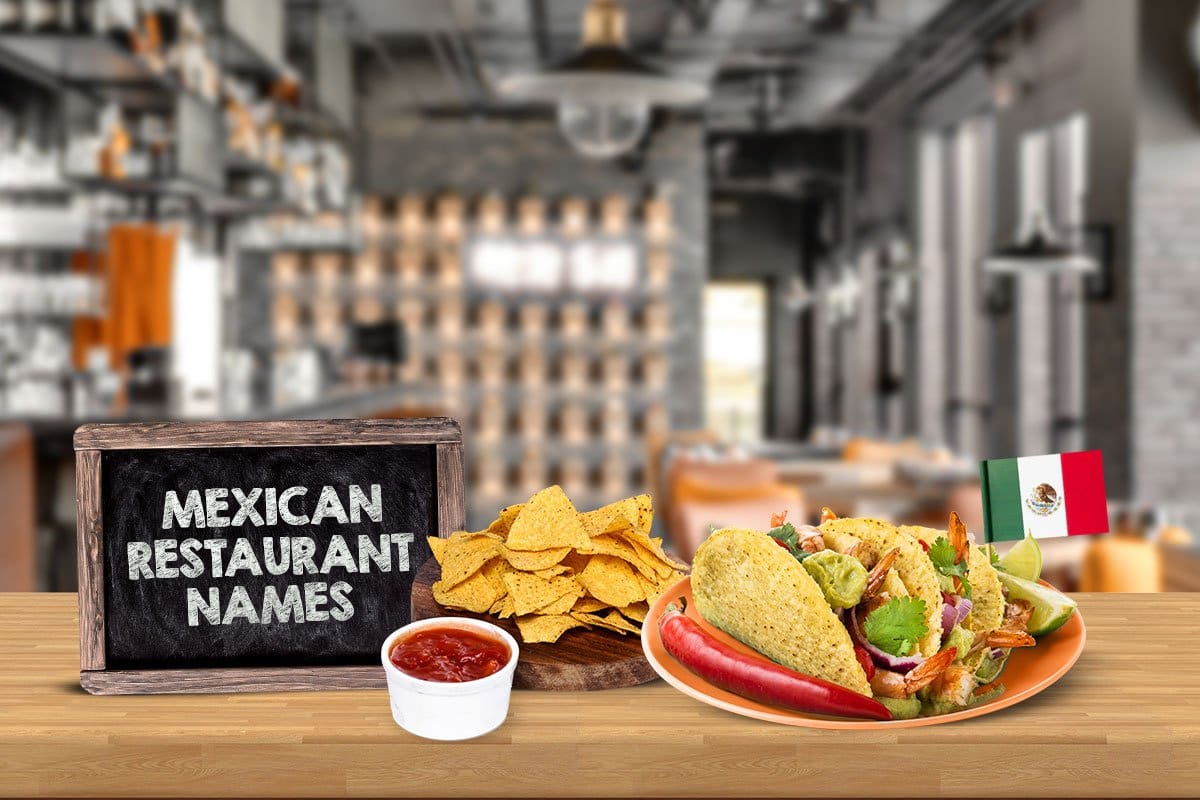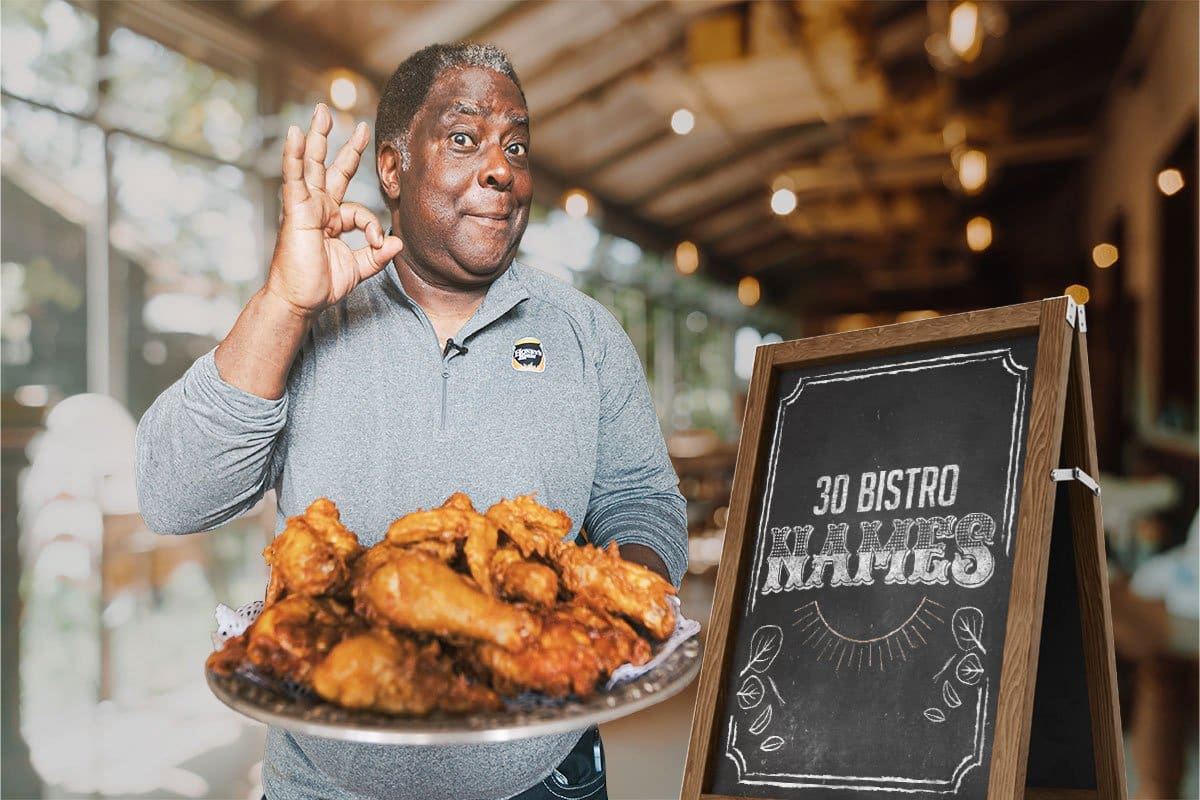So you’ve decided to open a restaurant but don’t know what to name it? That’s okay. We have plenty of restaurant name ideas you’ll love.
What should I name my restaurant?

Choosing a great restaurant name can be a challenge. We’ve got you covered with some tips to help you find the perfect name for your business.
- Consider a name that reflects the type of cuisine you offer or the overall theme of your restaurant. This gives potential customers a quick idea of what to expect.
- Unique restaurant names help you stand out. If you use a generic name, you might get lost in the crowd.
- Restaurant name ideas should be easy to remember.
- A culinary venture might want to include a reference to its location.
- You’ll want to check if your restaurant name ideas list has trademark availability, then check domain names and social media platforms to see if the good restaurant names are taken.
Remember, the name of your restaurant is a key part of your brand, so take the time to brainstorm and choose a name that resonates with your vision and target audience.
32 fancy restaurant names
If you want to attract bougie guests to your restaurant, choose a fine dining restaurant name that will impress. First, impress them with your name…then stun them with your impeccable service and first-class cuisine. Here are some fine dining name ideas that will help you make it happen:
1. Aurelian Elegance
2. Orchid Row
3. Éclat Manor
4. Imperium
5. Luxe Lumière
6. Crown on the Plaza
7. Prestige Cellars
8. Riviera Regale
9. Sérénité Soirée
10. Enclave
11. Étoile
12. Maison Tres
13. Café Grandeur
14. Rendezvous
15. Château Chantilly
16. The Emporium
17. Refined Revelry
18. Epicure
19. Illustrious Ivy
20. The New Gourmand
21. Ember
22. Resplendent Ridge
23. Epitome Elegance
24. Luminance
25. Nouveau Table
26. Vista Vérité
27. Apogee Amour
28. In Aura
29. Palatial Palate
30. Panache
31. The Gilded Gastronome
32. Epicurean Elegance
Pro Tip: When it comes to naming a fine dining restaurant, you can go one of two ways: trendy or classic. Select which one you think will draw in your target customer and also be a name you can live with for the life of your restaurant.
20 cute restaurant names
Attracting families and kids to your restaurant is easy when its name is adorable. A good restaurant name attracts potential customers to your establishment—just make sure your restaurant’s mission matches the name or else it will be ineffective.
1. Whisker’s Whimsy Wagon
2. Sweet Pea Patisserie
3. Sprout ’n’ Sprinkle Spot
4. Bubblegum Bunny Bistro
5. Fairy Floss Café
6. Teddy’s Tea Party Tavern
7. Sugar Sprinkle Shack
8. Cotton Candy Cottage
9. Snuggle Bug Bistro
10. Raindrop Ranch Café
11. Kitten’s Kitchenette
12. Sunshine & Sprinkles Café
13. Sweetheart Seashore Shack
14. Cupid’s Café Corner
15. Sugar Plum Fairy Feasts
16. Little Lamb Luncheon
17. Panda Palate Palace
18. Bunny Hop Bistro
19. Cleopatra’s Culinary Haven
20. Galaxy Grub
Pro Tip: You don’t just have to make your name creative, but make it a creative restaurant. The interior should be fun and inviting. Hang local art on the walls and create an atmosphere families will continually come back to.
30 fast food restaurant names

As a business owner, you want your fast food restaurant name to make a lasting impression. We have a great ideas list for you to choose from so you can guarantee you have repeat business time and again.
1. ZapBite Burger Co.
2. Rapid Munch Drive-Thru
3. Swift Savor Express
4. Dash Burger Bistro
5. ZipTaste Tavern
6. SpeedySizzle Grill
7. Snap Chow Hut
8. On the Rise Burgers
9. BlazeBite Fast Fare
10. Zest Meal Spot
11. TurboTaste Drive-Thru
12. Rapid Fuel Bistro
13. Quick Crave Corner
14. Rush Bite Express
15. Dash Munch Depot
16. Speedy Chow Hut
17. Express Burger Joint
18. Swifty Feast Drive-Thru
19. Fast Flash Fare
20. Blaze Bite Express
21. Zoom Burger Stop
22. Snap Chow Shack
23. RushBite Grill
24. Quick Fuel Fast Food
25. RapidRise Diner
26. ZippyMunch Depot
27. Swift Serve Fast Fare
28. Wizard of Oz Grill
29. Apollo’s Pizzeria
30. Einstein’s Edible Emporium
Pro Tip: What are your unique selling points that would make someone come to your place over other restaurants in the area like McDonald’s? Use your social media channels to get the word out there. The first impression someone has will stay with them forever. Build your brand identity from the very beginning.
Try Our Restaurant Name Generator
Choosing a business name can be hard, but it doesn’t have to be. Try our business name generator and get 12 business name ideas, plus find out whether they are available as domain names.
30 American restaurant names
American restaurants focus on cooking and serving food like burgers, chicken, and a variety of other options diners associate with Americana. Here are some names that will help your restaurant stand out from the pack:
1. Jazz Junction Diner
2. Great Lakes Galore
3. Southern Spice Station
4. Capital City Eats
5. Big Sky Bistro
6. Redwood Roots Restaurant
7. Everglades Epicure
8. Route 66 Diner
9. Aloha Avenue Café
10. Desert Bloom Bistro
11. Gulf Shores Grille
12. Cascade Café
13. Rocky Roadhouse
14. Magnolia Manor Eats
15. Wild West Whiskers
16. Blue Ridge Bistro
17. Crescent City Cuisine
18. Northern Lights Nosh
19. Grand Canyon Grillhouse
20. Napa Valley Nibbles
21. The Rockies Retreat
22. Sunshine State Supper Club
23. Ozark Oasis Bistro
24. Mount Rushmore Munchies
25. Hudson Valley Hideaway
26. Alamo Alley Café
27. Tundra Trails Tavern
28. Niagara Nosh House
29. Appalachian Attic Eats
30. Bayou Bonfire Bistro
30 Mexican restaurant name ideas

The easy way to name your Mexican restaurant is to simply put whatever name you choose in Spanish. But make sure it actually says what you want it to say so your name lets customers know what to expect when they dine there.
1. Sabor del Sol
2. El Sabroso Cantina
3. Casa de Sazón
4. Delicias de México
5. El Corazón de México
6. La Cocina del Sol
7. Tacos y Tequila
8. Sabores de México
9. El Rincón Picante
10. La Fiesta Mexicana
11. Taquería Tradicional
12. El Ranchito Sabroso
13. Los Sabores Auténticos
14. Comida Mexicana Real
15. Cantina del Sol
16. La Hacienda del Sabor
17. El Sazón Auténtico
18. Las Delicias Mexicanas
19. El Patio Mexicano
20. Sabores y Aromas de México
21. La Cabaña Mexicana
22. El Sabor de Mi Tierra
23. La Cocina Mexicana
24. Auténticos Tamales y Tacos
25. Sazón de la Abuela
26. El Fogón Mexicano
27. Tacos al Pastor y Más
28. La Esquina Mexicana
29. Delicias Caseras de México
30. El Paladar Mexicano
Expert Advice: Your name should evoke a feeling for the potential guest. What do you want your customer to think of when they hear your name? Is it an experience, a food, great service? Make your name something unforgettable.
30 Italian restaurant name ideas
When selecting an Italian restaurant name, be sure to include words that remind people of Italy and the amazing food they’ve had (or imagined having!) overseas. You can make it fancy or fun. These Italian restaurant names are good for everything from a nice Italian restaurant to pizza and hoagie shops.
1. Bella Cucina
2. Trattoria Romantica
3. La Dolce Vita Ristorante
4. Cucina del Sole
5. Gustoso Italiano
6. Sapori d’Italia
7. Piazza Italia
8. La Cantina della Nonna
9. Al Dente Trattoria
10. Ristorante Buon Gusto
11. La Famiglia Cucina
12. Bella Napoli
13. La Cucina Felice
14. Gusti del Sud
15. La Tavola Trattoria
16. Buona Cucina Italiana
17. Mangia Bene Ristorante
18. Le Delizie Italiane
19. Trattoria del Cuore
20. Osteria del Sole
21. Cucina Amore
22. La Cucina del Gourmet
23. La Pizzeria Rustica
24. Vivace Cucina
25. L’Angolo della Pasta
26. Il Gusto Autentico
27. Delizie D’Italia
28. Il Sapore Italiano
29. La Locanda del Cuoco
30. Trattoria Bella Luna
Pro Tip: Some Italian names can be hard for the average American to pronounce. While it may look nice, make sure the average Joe can pronounce your name or else it will be butchered time and again and your target customer may have a hard time finding you.
30 French restaurant names
Your French restaurant name should include keywords that will show potential customers what your restaurant is all about. Use culinary imagery to inspire them to dine there time and again. Of course you’ll want to make sure you love it as well!
1. Maison de Savoureux
2. L’Éclat Culinaire
3. Le Bistrot de la Coquette
4. L’Étoile Épicurienne
5. Bon Appétit Bistro
6. La Cuisine Charmante
7. Chez L’Artisan
8. Le Délice de Paris
9. Rendezvous Rive Gauch
10. Le Festin Français
11. À Table!
12. L’Auberge du Gourmet
13. Le Petit Plaisir
14. Delice de la Côte
15. La Vie en Rose Brasserie
16. Brasserie Bonheur
17. Le Repaire de Saveurs
18. La Cigogne Gourmande
19. La Provence Gourmande
20. Étoile du Matin
21. Les Délices de la Rivière
22. Belle Assiette
23. Bistro du Soleil
24. Salon Culinaire
25. La Table des Artistes
26. Le Café des Amis
27. Le Bon Vivant
28. Cuisine en Rose
29. L’Escapade Gourmande
30. Trattoria du Midi
Pro Tip: French restaurant name ideas are easy to come up with when you look at how beautiful the language is, both spoken and written. Play with combinations, and you shouldn’t have any trouble coming up with the perfect restaurant name as long as it resonates with your menu and dining experience.
22 diner names
Get those creative juices flowing as you decide on a perfect diner name for your new restaurant. This isn’t just a place to serve food. You’ll be creating delicious dishes and a divine dining experience that will wow your guests, so be sure you have a restaurant name to match.
1. Retro Rocket Diner
2. Tasty Tracks Diner
3. Cosmic Café
4. Flamingo Flavors Diner
5. Blue Moon Bites
6. Starlight Bites
7. Killer Pizza & Sammies Diner
8. Route 66 Eats
9. Atomic Appetites Diner
10. Neon Nights Diner
11. Thunderbird Treatbox
12. Jukebox Jive Diner
13. Bonanza Bites
14. Sock Hop Stop Diner
15. Diner-o-Saurus
16. Rock ’n’ Roll Grub Hub
17. Galaxy Grill
18. Cosmic Cravings Diner
19. Diner Delight Junction
20. Mellow Yellow Diner
21. Retro Rendezvous
22. The Food Truck Diner
Pro Tip: Pick a theme for your diner. Themes are a great way to attract customers and build a strong brand identity. You can even make promotional materials for your new business that feature your theme and make people want to come for a meal!
22 fancy café names

But here are a few fancy restaurant names for your café that are sure to inspire your culinary venture.
1. Serene Sips Café
2. Château du Café
3. Elysian Espresso
4. Enchanted Eats Emporium
5. La Vie en Rose Café
6. Royal Brew House
7. Gourmet Garden Café
8. Éclatant Elegance
9. Belle Bistro
10. Palais de Pâtisserie
11. Tranquil Tea Terrace
12. Paragon Perks Café
13. Posh Palette Café
14. Elite Elixir Emporium
15. Luxe Lounge Lattes
16. Opulent Oasis Café
17. Café Magnifique
18. Divine Delights Diner
19. Paradiso Patisserie
20. Grandeur Grinds
21. Gourmet Symphony Pastry & Beans
22. Café Gilberto
Pro Tip: Creative restaurant name ideas leave a lasting impression on your branding efforts. Check the availability of the perfect name using online tools.
20 buffet restaurant names
Consider some of these suggested names for all-you-can-eat restaurant businesses.
1. Worldly Flavors Buffet
2. Culinary Odyssey Buffet
3. Fusion Feast Buffet
4. Melting Pot Buffet
5. Global Gastronomy Buffet
6. Panorama Plate Buffet
7. Eclectic Eats Buffet
8. International Indulgence Buffet
9. Diverse Dining Buffet
10. Ethnic Enclave Buffet
11. Flavor Fusion Buffet
12. Gastronomic Galore Buffet
13. Epicurean Expedition Buffet
14. Heritage Heights Buffet
15. Taste Trek Buffet
16. Crossroads Cuisine Buffet
17. Mosaic Buffet
18. Pan-Continental Buffet
19. Culinary Kaleidoscope Buffet
20. All You Can Eat Oasis Buffet
30 bistro names

Consider some of these creative restaurant names for a bistro.
1. Sage & Saffron Bistro
2. Azure Vine Bistro
3. Velvet Petal Bistro
4. Hearthstone Haven Bistro
5. Moonlit Terrace Bistro
6. Willow Whisper Bistro
7. Ember & Elm Bistro
8. Sunflower Serenade Bistro
9. Cobblestone Corner Bistro
10. The Tango Bistro
11. Juniper Junction Bistro
12. Quill & Quinoa Bistro
13. Zephyr Zenith Bistro
14. Rustic Aura Bistro
15. Echoes & Eats Bistro
16. Cobalt Cascade Bistro
17. Alchemy Alley Bistro
18. Luna Lounge Bistro
19. Cedar Crest Bistro
20. Elysian Eats Bistro
21. Tarragon Terrace Bistro
22. Opal Orchid Bistro
23. Citrine Cove Bistro
24. Bistro 360°
25. Marigold Manor Bistro
26. Whispering Woods Bistro
27. Three Serenades Bistro
28. Coral Cascade Bistro
29. Amethyst Arbor Bistro
30. Fireside Flavors Bistro
30 ‘punny’ restaurant names
What are some restaurant names that will make you laugh? We have a few answers below. Restaurant owners who aren’t afraid to include a good pun can benefit from a cute restaurant name that diners won’t soon forget. Here are some restaurant business name ideas that leverage just the right amount of humor and hint at the delicious cuisine you’ll serve.
1. Wok Around the Clock
2. Soy Joy Eatery
3. Stir Crazy Noodle Bar
4. Pho-nomenal Eats
5. Kimchi Krazy
6. Dim Sum Delight
7. Miso Happy Eatery
8. Thai Me Up
9. Wonton Wonder
10. Rice Rice Baby
11. Kung Food Palace
12. Zen Zest Fusion
13. Curry in a Hurry
14. Sushi-licious Spot
15. Tempura Temptations
16. Chop Chop Chopsticks
17. Bao Down Bistro
18. Spice Route Café
19. Noodlegate Kitchen
20. Dumpling Dynasty
21. Ramen Rave
22. Pho Real Bistro
23. Szechuan Sensation
24. Dragon Delish Diner
25. Rollin’ Rollin’ Sushi
26. Wasabi Wow Café
27. Sesame Street Eats
28. Hoisin Haven
29. Kimchili Kitchen
30. Thai Tanic Treats
30 beach restaurant names
A restaurant business on the beach might consider some of these new ideas for a beachy business name:
1. Sandy Toes Café
2. Seaside Bites Shack
3. Wavefront Eats
4. Shoreline Sip Spot
5. Flip Flop Fusion
6. Driftwood Diner
7. Beachcomber’s Bistro
8. Saltwater Serenade Café
9. Sunkissed Eateries
10. Seashell Shoreline Snacks
11. Tidepool Treats Tavern
12. Coral Cove Cuisine
13. Seafoam Feasts
14. Boardwalk Bites
15. Coastal Cravings Café
16. Pier Pleasures Restaurant
17. Castaway Cove Café
18. Tiki Tide Tavern
19. Bay Breezes Bistro
20. Lighthouse Lunches
21. Nautical Nosh Nook
22. The Mermaid’s Menu
23. Palm Tree Pantry
24. Seagull’s Perch Café
25. Shell Seeker’s Snack Shack
26. Beach Blanket Bistro
27. Sailors’ Supper Spot
28. Sandcastle Café
29. Surfer’s Slice Shack
30. Beach Bonfire Bites
30 brunch restaurant names
Brunch restaurant names are great for attracting those people who can’t decide if they want to get breakfast or lunch.
1. Rise & Dine Café
2. Morning Bliss Bistro
3. Brunchville Bites
4. Sunny Side Up Café
5. Brunch & Munch
6. Daybreak Delights
7. Sunlit Brunchery
8. Early Bird Eats
9. Brunch O’Clock
10. Brunch Barn
11.Midday Munchies Café
12. The Bungalow
13. Sunrise Savory Spot
14. The Brunch Basket
15. Breakfast Boulevard
16. Brunch Bonanza
17. Astrud’s Brunchery
18. Sunbeam Brunch Café
19. Morning Glory Eateries
20. Brunchtime Bliss
21. The Morning Table
22. Brunch Affair Café
23. Bistro Brunchscape
24. Rise & Brunch Café
25. Morning Medley Diner
26. Brunch Oasis
27. Brunch Junction
28. The Brunch Clubhouse
29. Sunlit Spread Café
30. Morning Breeze Bistro
30 modern restaurant names

Modern restaurants are defined by their sleek decor and menus that wow diners with innovative options. They increasingly focus on local food and sustainability, too.
1. Urban Palette Eats
2. Metropolis Munchery
3. Modernity Bites
4. Chic & Eats
5. Vibe Valley Eatery
6. Fusion Flux Café
7. Nova Bistro Lounge
8. Trendy Tabletop
9. Echo Eats
10. Zenith Zone Café
11. Savor Sphere
12. Retro Remix Diner
13. Avant Grub
14. Urban Utopia Eats
15. Fusion Foundry
16. Pixel Plate Bistro
17. Pulse Point Eatery
18. Artisan Alley Café
19. The Mod Mix Diner
20. Metro Manifesto
21. Flavor Fusion X
22. Chic & Savory Eats
23. Urban Elegance Eateries
24. Modish
25. The Trend Tavern
26. Urbanite Eatscape
27. Fluxus Bistro
28. ModMotion Café
29. Metro Mingle Bistro
30. Tres Forma Eatery
30 fantasy restaurant names
1. Enchanted Eats Emporium
2. Mystic Morsels Tavern
3. Dragon’s Delight Diner
4. Fairyland Feasts
5. Unicorn Utopia Café
6. Sorcerer’s Supper Spot
7. Celestial Cuisine Castle
8. Elf & Elemental Eatery
9. Enigma Eats Emporium
10. Phoenix Flame Bistro
11. Mage’s Menu Manor
12. Mythical Munchery
13. Mermaid’s Galley
14. Fabled Fare Feasts
15. Wizardry & Wonders Diner
16. Griffin’s Gourmet Guild
17. Seraphic Supper Spot
18. Fey Feasthouse
19. Astral Aura Eateries
20. Chrono Culinary Cove
21. Arcane Appetites Café
22. Cosmic Creatures Café
23. Elven Enclave Eats
24. Enchanted Grove Grub
25. Dreamer’s Dining Den
26. Enigma Elixirs Eatery
27. Wyvern’s Wok
28. Faerie Fusions
29. Valkyrie’s Vanguard Venue
30. Cosmic Concoctions Castle
20 breakfast restaurant names
1. Rise & Dine Café
2. Morning Glory Griddle
3. Breakfast Boulevard
4. Sunshine Café & Grub
5. Early Riser Eateries
6. Crispy Mornings Café
7. Flapjack Palace
8. Sunny Side Spot
9. Morning Bites Buffet
10. Early Bird Eats
11. The Breakfast Clubhouse
12. Rise ’n’ Shine Café
13. Daybreak Diner Delights
14. Sunrise Serenade Café
15. Crave & Savor Breakfast
16. Golden Morning Griddle
17. Pancake Paradise
18. Morning Morsels Café
19. Fresh Start Eateries
20. A.M. Delights Diner
Did you find some cool restaurant names?
We provided lists of names you might like for your own restaurant. The restaurant’s concept will play a heavy role in how you name your business. A name that will work for a coffee shop won’t work for an elegant restaurant.
Take the time to think about what type of restaurant business you’ll start, then come up with a list of your top names for restaurants. Once you’ve settled on good names of restaurants, check that they are available as a web domain, social media profiles, and as business names.
Did this blog help you think of cool names for your business?




